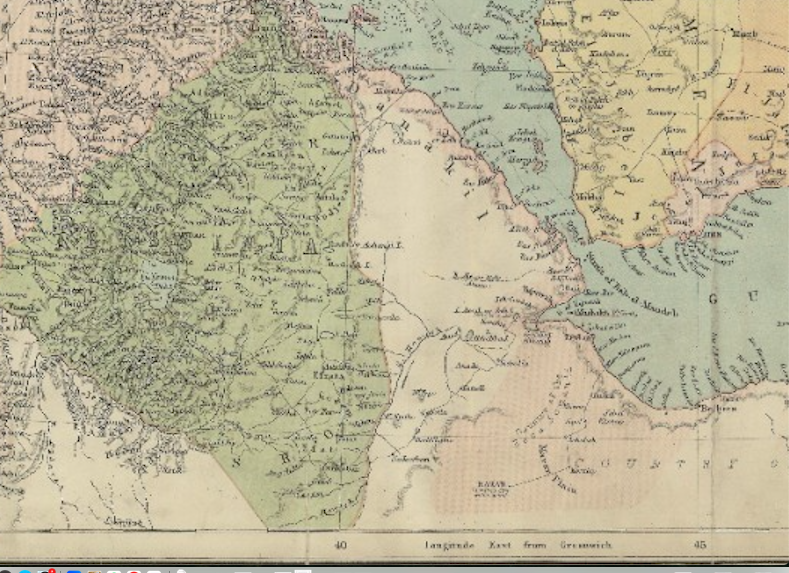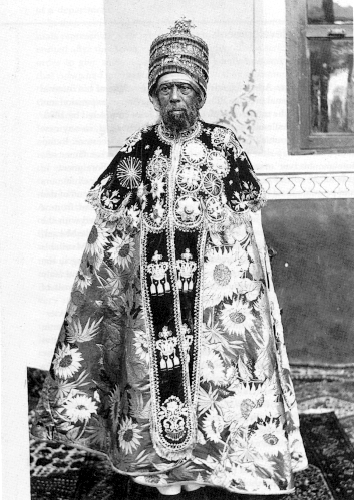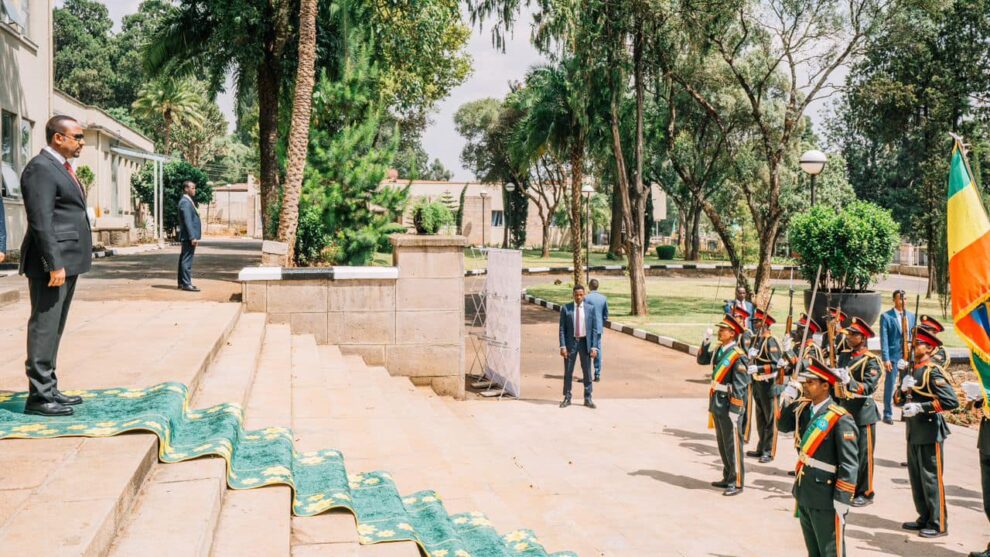Ethiopia’s claims to a historical right to Red Sea access are as old as the invention of modern Ethiopia itself.
On October 13, 2023, Prime Minister Abiy Ahmed, addressing members of the Ethiopian parliament asserted that Ethiopia has a natural, legal, historical, and demographic right to own an outlet to the Red Sea. He put forth a historically contentious claim, suggesting that Ethiopia was a maritime power for centuries until losing its access to the sea following Eritrea’s independence in 1991. Casting the question of port ownership and sea outlet as existential to Ethiopia’s teeming population, Abiy Ahmed argued that the issue is not a matter of luxury for his country and insisted on regaining Ethiopia’s historical place in the Red Sea either peacefully or by force.
Since his speech to the parliament and subsequent appearance in November, Ethiopian state media outlets, officials, and a motley of state-affiliated social media activists are whipping up an aggressive campaign mainly aimed at Eritrea, in contravention to the purposes and principles of the UN charter, which obliges states to refrain from threats or the use of force to violate the sovereignty and territorial integrity of another state. In the proverbially ambiguous language of Ethiopian politics, the discourse alternates between aggressive irredentism and historical revisionism, arguing for Ethiopia’s ownership of sea outlet and ports, and softer requests for access to the sea based on regional cooperation and complimentarity.
Nothing of this discourse is new. It is as old as the invention of modern Ethiopia as spatially bounded and cartographically delineated state at the turn of the 19th and early 20th centuries.
Ethiopia: A Floating Signifier

Crop of 1885 Map of Egypt and the Soudan, including the valley of the Nile, the Red Sea, Abyssinia, Arabia, etc. Note that the Abyssinian Empire had not yet incorporated the territories that now constitute much of southern, western and eastern Ethiopia – ie. Oromia, Southern Nations, Nationalities and Peoples, Ogaden and Harar Source: Royal Geographical Society (with IBG)
Ethiopian leaders, past and present, tend to exhibit what Christopher Clapham, a notable Ethiopianist, characterizes as a pretension to universal jurisdiction. They lay claim to extensive territories some of which they have never set foot on or exerted effective control over. Before the European scramble for Africa at the end of the 19th century, Ethiopian leaders lacked a definitive notion of their territorial boundaries. Ethiopia, also widely known as Abyssinia, was a floating signifier referring to an indeterminate geopolitical entity that did not correspond with the actually-existing Ethiopian/Abyssinian state.
For example, The Kebre Negest, a 14th century manuscript used as a source of legitimacy and sovereignty by Ethiopian leaders, narrates the legend of Abyssinian kings and their genealogical claims that the “Emperor of Ethiopia” rules all the territories from:
“[T]he middle of Jerusalem from the north thereof to the south and to Western India… The eastern boundary of the kingdom of the king of Ethiopia [starts in] the city of Gaza in the land of Judah, that is, Jerusalem; and its boundary is the Lake of Jericho, and it passeth on by the coast of its sea to Leba and Saba; and its boundary goeth down to Bisis and Asnet; and its boundary is the Sea of the Blacks and Naked Men, and goeth up Mount Kêbêrênêyôn into the Sea of Darkness, that is to say, the place where the sun setteth and its boundary extendeth to Fene’el and Lasifala and its borders are the lands (near) the Garden (i.e. Paradise), where there is food in plenty and abundance of cattle, and near Feneken; and its boundary reacheth as far as Zewel and passeth on to the sea of India; and its boundary is as far as the Sea of Tarsis, and in its remote part lieth the Sea of Medyam…”
The reference to Jerusalem and other Biblical places as part of the Ethiopian territorial domain is symbolic of the profane and sacred geographic registers within which pre-modern Ethiopian leaders understood their realm. The Kebre Negest was highly esteemed by Abyssinian leaders as, among other things, a geographical document that outlines Ethiopia’s domain. Emperor Yohannes IV (1871-1889) wrote a letter to Queen Victoria and Lord Granville, the British Foreign Secretary, requesting the return of a copy of Kebre Negest taken to England in the wake of the Napier Expedition in 1868. In his letter, Emperor Yohannes pleaded with the British Queen and her Foreign Secretary to send him the Kebre Negest because it contained vital details about the laws, territories and names of chiefs of his country.”
The assertion of sovereignty over expansive territories not under Ethiopian/Abyssinian actual control was reproduced by various European cartographers, travellers, and missionaries. In most European maps published between the 16th and 19th centuries, Abyssinian territorial domain is depicted as extending as far as the Indian Ocean coast of present-day northern Mozambique and reaching the Atlantic Ocean in northern Angola.

The suicide of the Emperor (negus) of Ethiopia Theodoros II (Tewodros) (circa 1818-1868), on April 13, 1868, after the torching of his fort at Magdela by the British. Considered the first ruler of Abyssinia after the Zemene Mesafint (the Age of the Princes), his reign (1855 – 1868) marks the start of the Abyssinian Empire. (Drawing by Emile Bayard after an English sketch. Engraving published in: Narrative of a Journey through Abyssinia by Guillaume Lejean from El Mundo en La Mano 1879 by Jerónimo Alba. Photo courtesy: Joseph Ettlin)
When European powers began establishing colonial enclaves, protectorates, and spheres of influence in the Horn of Africa at the end of 19th century, Ethiopian emperors — first, Emperor Yohannes IV (1871-1889) and later, Emperor Menelik II (1889-1911)— invoked the boundless geographic imagery of Ethiopia to assert jurisdiction over a huge swath of land and independent societies, of which they had neither knowledge nor any meaningful juridical-administrative control. In 1891, for example, Emperor Menelik II sent a circular to European powers – a document suggested and drafted by the Italian Resident-Agent in Addis Ababa, Count Augusto Salimbeni. In this letter, the emperor described the boundaries of his empire and vowed to “re-establish the ancient frontiers of Ethiopia up to Khartoum and as far as Lake Nyanza [Lake Victoria] with all the Gallas [derogatory racist term used to refer to Oromos],” if God granted him long life and strength.
The Italians, by then in control of their colonial primogenita, Eritrea, were encouraging Emperor Menelik to lay claim to territories not directly under his control because they were still hopeful that they would make Menelik’s Ethiopia an Italian protectorate. In boundary negotiations with the British, who insisted on delineating the frontiers of their colonies in Sudan, Somaliland, Kenya, and Uganda with Ethiopia, Emperor Menelik declared to the British Envoy, Raynold Rhodes, that he considered Ethiopia’s boundaries to be extending from “2- and 14-degree north latitude, the shore of the ocean [Indian] on the east, and the right bank of the Nile on the west.” Ethiopia’s colonialist claim over territories and peoples that did not belong to it was not limited to declarations and circulating of letters. It mobilized its entire war machinery to realise its imperial project and subjugated hitherto autonomous populations and territories, thereby creating a prison-house of nations and nationalities.
The current Ethiopian Prime Minister, Abiy Ahmed, can be likened to a taxidermist clumsily attempting to re-create a facsimile of what he imagines to be a once-glorious ports-owning, seafaring Ethiopian empire. He and his coterie of cadres are hard at work to resurrect the image of a mighty Ethiopian empire whose territorial bounds presumably go beyond its current boundaries to include the Eritrean coast. However, they are mounting this image on the wobbly and rusty scaffolding of historical inaccuracies and myths.
Ethiopia has never been a maritime power in its history. As a matter of historical fact, Ethiopia as we know it today, did not even exist prior to the European scramble for Africa at the turn of the 20th century. Despite the tired but entrenched fiction that portrays Ethiopia as an ancient polity with fixed and sacred boundaries, the history of the emergence of Ethiopia as a spatially bounded polity is no different than other African countries. Ethiopia was not colonised; however, its definitive boundaries were colonially determined.
The Eritrean Coast: Autonomous Frontier Zone between Empires
Abyssinia, the precursor to modern Ethiopia, was not seriously preoccupied with owning or controlling a sea outlet. Thus, the notion that Ethiopia was historically a maritime state and had ownership over the Red Sea coast is pure historical fiction. From the early 16th to the latter half of the 19th century, the Red Sea was essentially an Ottoman Sea, wherein powerful local intermediaries ruled and collected tributes on behalf of the Sublime Porte in Istanbul. The fate of the Eritrean coast was no different.
Except for a brief period, the Ottomans did not rule the Eritrean coast directly. They delegated their authority to a local Beja-descended Belaw ruling family, known as the Na’ibs, who ruled the Eritrean coast and the adjacent inland territories until the Italian occupation of Massawa in 1885. The Na’ibs annually sent part of the customs duties they collected to Istanbul but maintained significant autonomy. In Eritrean historiography, the period between mid-16th and end of the 19th centuries is referred to as Ottoman-Turkish colonialism. However, characterizing it as colonialism is a misnomer. The Ottoman jurisdiction over the Eritrean coast was nominal and indirect. The prevailing emphasis among historians has been on the inter-imperial – Ethiopian, Ottoman and European – competition to control the Eritrean coast. The focus on major imperial actors elides the agency of local actors and the extraordinary skill they displayed in successfully preserving their autonomy from direct imperial control.
During their 350-year rule, the Na’ibs exerted control over crucial trade routes, spanning from Massawa into the interior, and extended their authority over a large portion of present-day Eritrea such as Habab, Mensae, Bogos (Sahel and Senhit), parts of highland provinces of Akkala Guzay and Hamassien (highland provinces), Buri peninsula, Zula, and territories along the Afar coast down to Edi, and the Dahlak islands. Their imposition of custom duties on merchandise transported from the interior to the coast allowed them to amass substantial revenues, thereby strengthening their political influence.

Under Menelik II (1889 – 1913), the Abyssinian Empire relied on the port for primarily two functions: the exportation of slaves, mostly from Oromia, and the importation of firearms. Source: Public Domain, https://commons.wikimedia.org/w/index.php?curid=9415893
As a noted historian of the Red Sea, Jonathan Miran, asserts, the 19th century saw a surge in the transportation of Northeast African slaves across the Red Sea, surpassing any other period in history. This increase in the slave trade was attributed to the tumultuous state-building processes in Ethiopia and the heightened integration of the region into the global capitalist economy. Conservative estimates by historians suggest that out of half a million slaves shipped across the Red Sea in the 19th century, approximately 111,000 were transported through Massawa. Majority of these slaves hailed from southwestern and western Ethiopia, particularly from predominantly Oromo places like Jimma, Limmu, Gomma, Leeqa, and Kaffa. It’s a striking irony that Abiy Ahmed, an Oromo born in Gomma Woreda, is currently promoting a misleading narrative of Ethiopia’s historical ownership of the Red Sea.
What Should be Done?
At any rate, historical debates about the nature of pre-colonial territoriality and sovereignty do not have bearings on the territorial questions of current African states. In the African context, the postcolonial states legitimised their sovereignty on the sanctity of colonial boundaries. Members of the Organization of African Unity (OAU) had agreed to respect the frontiers existing on their achievement of national independence on the principle of uti possidetis juris (as you possess under the law) in 1964.
The first three principles of the organization of the Organization of African Unity assert the sovereign equality of states and respect for the sovereign and territorial integrity of each state. The consideration of colonial boundaries as sacred and inviolable was not universal in Africa. Some African leaders envisioned a different form of postcolonial reality other than the states inherited from colonialism: there was a pan-African vision that sought to unite Africa under a singular political umbrella, and there were Africans who wanted to remake the colonial boundaries based on ethnic and national affinities. Ironically, Ethiopia, despite its irredentist claims over Eritrea, was among those states who argued for the maintenance of colonial boundaries.
As the seat of the African Union, Ethiopia should do away with its colonial entitlement, measure up to its status and adhere to one of the foundational principles of the Union. Ports and territorial waters, unlike high seas and the deep sea and ocean floor, are not res communis. They are part of the inviolable and exclusive sovereign territory of a state. Arguments about demographic bulge or historical prestige are not a legitimate basis to contravene these fundamental hallmarks of international law. In fact, that Lebensraum (“living space”) justifies aggression is wrong whether advanced by Germany or Ethiopia.

Comrades: Isaias and Meles. Until their bitter falling out, which led to the Badme war in 1998 and the death of over 100,000, Eritrea gave Ethiopia unfettered access to all Eritrean ports, for which they were required to pay in Ethiopian Birr. Photo courtesy: ‘I Love Tigrinya’ on social media.
What Ethiopia can do to address its sea access needs is to negotiate with its neighboring countries in good faith. As far as Eritrea is concerned, Ethiopia had absolutely no problem with port services. As a matter of fact, and against Eritrea’s best economic interest, Ethiopia was using Eritrean ports for free between 1991 and 1997. As per Article 4 of the Agreement of Friendship and Cooperation between the Transitional Government of Ethiopia (TGE) and the State of Eritrea signed in July 1993, Ethiopia enjoyed full and unrestricted use of the port of Assab. The Ethiopian Shipping Lines handled its own cargo paying Eritrea in its local currency, Birr, for consignment fees it received in foreign currency. The Agreement of Friendship and Cooperation also allowed Ethiopia to use the port of Massawa for its northern regions at minimal fees and payments – a transit charge of only 1.5%. We can talk about having similar arrangements that can be of mutual benefit for Eritrea and Ethiopia. However, to resurrect the old Ethiopian imperialist ghosts is irresponsible warmongering.











